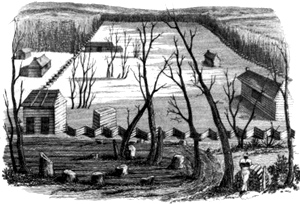
Nashoba
Nashoba was a short-lived, but internationally famous, utopian community on the present-day site of Germantown in Shelby County. Nashoba was founded in 1826 by Frances Wright, who dreamed of demonstrating a practical and effective alternative to the South’s slave-based agricultural economy. Hardly a trace of the community could be seen by 1830, but Nashoba survives in historical accounts of American utopias.
Wright and her sister Camilla were the daughters of a Scottish merchant and his aristocratic English wife, both of whom died when the girls were young. Reared by relatives in England and educated in London, they were, by the age of twenty, fluent in several languages and possessed of a remarkable self-assurance. With a substantial inheritance from their late father, the Wright sisters came to America as young women in 1818 and traveled freely about the country. A book she subsequently wrote–Views on Society and Manners in America–brought Frances Wright an impressive following, including Thomas Jefferson, Henry Clay, and the Marquis de Lafayette. It also led to a close and continuing relationship between the tall, vivacious, twenty-six-year-old Fanny, as she liked to be called, and the sixty-four-year-old Lafayette, then a widower living outside Paris.
When Lafayette came to the United States in 1824 on a triumphant return to the scenes of his heroism in the American Revolution, Wright followed. Visiting with Jefferson and others in the highest social and political circles, she sensed the plight of otherwise decent men caught up in the system of slavery, from which they could see no avenue of escape not tainted by financial ruin. Wright suggested one: a setting in which progressive whites and free blacks would live and work together in a sort of training school for independence.
In the summer of 1825 Wright put before Lafayette her proposal to buy a small number of slaves and set up a colony where they could be prepared to be self-supporting. She hoped such an example, if successful, might lead others to follow suit. Lafayette gave her an introduction to Andrew Jackson, who invited her to Tennessee to seek a site for the colony. Through Jackson and his Nashville friend John Overton, Wright located a two-thousand-acre tract of land near Memphis, then an unincorporated village of a few hundred residents. She decided to buy the site on the Wolf River east of Memphis and name it Nashoba–the Chickasaw word for “wolf.”
With a small group of idealistic young whites that included her sister, Wright formally launched her experiment in the spring of 1826. With the help of about fifteen former slaves whose freedom she had purchased, she and the others set about clearing land and building cabins. But the task was arduous and fraught with difficulties. Sickness and conflict within the little community and controversy sparked among outside critics dogged the settlers at every step.
Wright went to Europe in 1827 to raise funds for the venture, but by the time she returned, she found her idealistic dream of a new community of equals was gone; all that remained was a loose association of individuals. The white residents soon left. Only the blacks remained, their rights unrealized, their status unclear, their future in doubt. Wright herself soon moved to New Harmony, Indiana, with a fellow Scot, Robert Dale Owen. She and Owen went to New York, where she became active in a variety of social causes.
But Nashoba and its abandoned residents tugged at her conscience. In December 1829 she returned there to find thirty-one black residents barely holding body and soul together. She offered to take them to Haiti, where they could live as free people in a black-ruled nation, and the small group favorably received her offer. Early in 1830 the entire population of Nashoba and Wright sailed from New Orleans for Haiti. The young country’s president, Jean Pierre Boyer, who had been alerted to their arrival by the ever-helpful General Lafayette, greeted the group at Port-au-Prince. Thus ended the short and stormy life of Nashoba.
Suggested Reading
John Egerton, Visions of Utopia: Nashoba, Rugby, Ruskin (1977)



